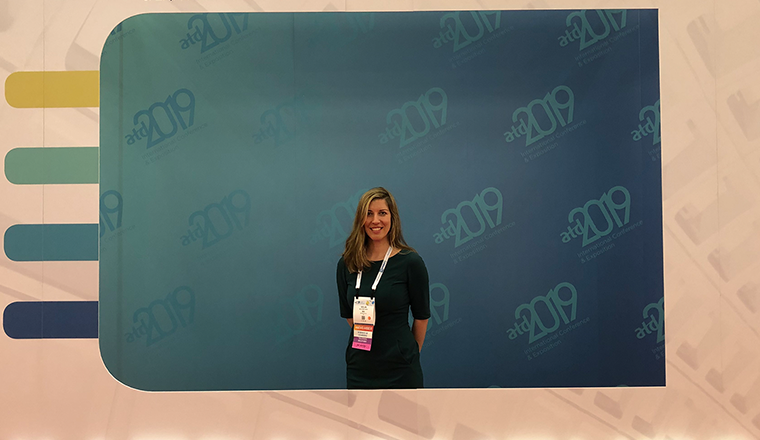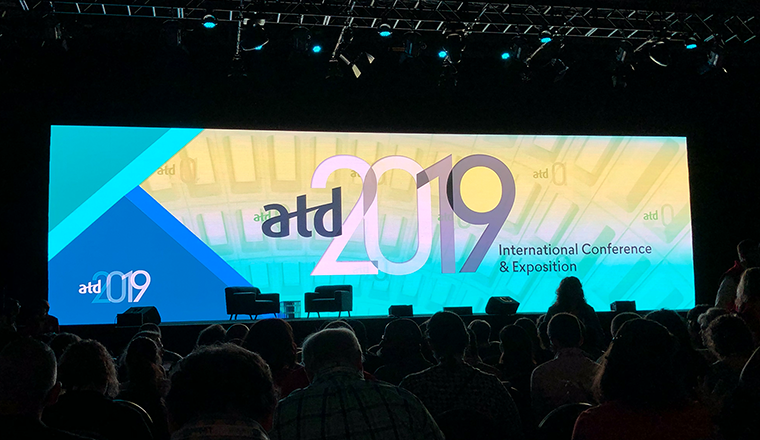- Blog
- / July 31, 2019
Learning from Learning: Bringing it All Together from My Perspective

It’s not surprising that I found myself at the recent Association for Talent Development’s International Conference. After all, part of my job is to develop in-person trainings and to use blended learning strategies to sustain learning beyond the classroom. However, I didn’t realize going into the conference just how much I myself would learn in a short time I was there. Putting myself in the role of “learner,” as opposed to “trainer,” gave me the chance to grow professionally and bring new insights to my job. Here’s what I took away about designing learning products, from presentations from industry leaders like, Britt Andreatta, Tim Slade, Ina Weinbauer-Heide, and Julie Dirksen:
1. Marketing tactics work in learning, too. Marketers have cracked the code in grabbing our attention by tapping into our brain’s visual and emotional processing functions. The right colorful visuals transmit valuable information instantaneously and can also impart positive emotional qualities to the information, making consumers more likely to purchase a particular product or service. When creating training materials, we should similarly use powerful visuals that are attention grabbing and create impactful participant engagement.
I wondered why visuals can be so powerful. It turns out that cognitive biases affect how we remember information, and we all have what’s called “picture superiority bias.” It helps use remember visual concepts more easily. As Tim Slade , an e-learning guru, stated during his session on creating engaging content through visual design, part of the job is to, “help your learners see what the trainer is saying.” This taps into our picture superiority bias. When a learner has to read through a text heavy slide while listening to the trainer talk, the learner may get lost and feel frustrated, defeating the purpose of the training as a learning opportunity. Rather than including all the text on the slide, including a visual that learners can associate with what the trainer is saying can help learners with recall. As learning professionals, we need to hook into picture superiority bias, so now I pair visuals with key messages to grab attention and evoke emotion to motivate learners.
2. Recognize our cognitive biases. Our biases impact what we remember. For example, our brains prefer simple rather than complex and ambiguous information. When writing for instruction, less is more. If we want our learners to remember and apply the knowledge and skills from the training, we need to be intentional in making our writing easy to understand. I have a handful of colleagues who conduct quality checks on my written content to ensure that the main messages are clear. It is equally important for us to keep in mind our tendency to favor information that confirms our beliefs. When we encounter information that we like and agree with, this helps us in remembering it. Being aware of this bias can help us keep ourselves in check when we may naturally want to reject information that we don’t agree with.
3. Cognitive overload is for real. In an effort to not overload our learners with information, we need to develop trainings that factor what we know about working memory and long-term memory into the design. Julie Dirksen describes how our memory processes new information and stores it in long-term memory as closets with shelves. If you are an expert on a topic, the shelves in your closet are categorized in a neat and detailed fashion and you know where to go to pull something out. Whereas with a non-expert, or in the context of my work, a learner in a training, the closet may not have any shelves or very few that are disorganized, and information is hard to retrieve. As learning professionals, it’s important to assess whether the amount of information being conveyed in a training is appropriate for the participants and presented in an organized manner. In my work we use pre-course surveys and interviews to understand the backgrounds and experiences of the learners. The ultimate goal is to create experiences that allow learners to remember and use new information on the job.
4. There is a solution to beating the forgetting curve. The forgetting curve, pioneered by Hermann Ebbinghaus in 1885, states that on average, learners can forget up to 70 percent of a training’s information within 24 hours. Considering all the resources we put into our training activities, that’s discouraging. But fear not! There is a solution to this: research on neuroscience and memory demonstrates that “learning boosts” to reinforce learning can increase information recall days and months after the training. The trick is to design the learning boosts in a way that learners can recall the information not through re-reading material, but through quizzing, which requires recall of information through spaced intervals. This is where microlearning has proven to be useful. Microlearning provides content to learners in small chunks spaced over time. It reinforces information before or after a big learning experience, and it helps learners work through exercises that require information recall. I want to invest my time designing learning boosts that have the right balance of push and pull of information to make a long-term impact.
5. Promote a learning journey to your learners – not just an event. The learning experiences we create should forge a path towards a continuous learning journey to ensure that the knowledge and skills are transferred onto the job. As suggested by Jason Durkee and Ian Townley, we can do this by providing:
I. opportunities for learners to practice their skills in the workplace;
II. clear messages to managers on the goals of the learning activity and how they can get involved in supporting their employee(s);
III. feedback that helps to refine the learner’s skills to their specific situation; and
IV. reinforcement for practice and recall.


The reality is that to accomplish any of these is easier said than done. Developing a learning transfer strategy, which include specific interventions that address the four factors, alongside leadership input can help launch this process. Ultimately, we want to make the learning a part of our learners’ regular routine rather than a one-off event to assure that they are constantly improving.
Workplace learning professionals’ goal is to meet our learners where they are so that they feel empowered to take ownership of the problems they are trying to solve. Taking advantage of the research on the science of learning will help us to achieve this goal and approach our learning initiatives in a way that solidifies the process of learning with the right amount of content, practice, feedback and reflection.